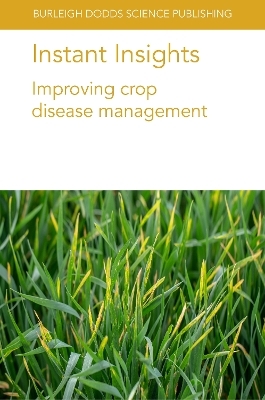
Instant Insights: Improving Crop Disease Management
Burleigh Dodds Science Publishing Limited (Verlag)
978-1-80146-169-6 (ISBN)
The first chapter reviews strategies for limiting foliar disease development in wheat and barley crops, such as crop rotations, intercropping, gene deployment and conservation tillage. It explores the effectiveness of each strategy against particular foliar diseases, as well as how these strategies can be deployed to reduce inoculum sources for residue-borne cereal leaf diseases.
The second chapter considers the use of integrated disease management (IDM) to prevent or reduce yield loss in wheat. The chapter reviews the tactics/tools used in IDM, such as scouting, disease identification and chemical control, and explores how these tactics can be implemented to maximise the effectiveness of managing diseases in wheat.
The third chapter assesses how IDM can be applied to barley production and considers the different disease threats, the tools available and possible approaches to deploying them. It also reviews the role of agronomy and how it can be used to optimise these tools.
The final chapter reviews the use of IDM in grain legume production and explores the deployment of traditional strategies, such as field and crop management, as well as advanced monitoring methods, modelling and molecular methods to control disease outbreaks in grain legumes.
Chapter 1 - The role of crop rotation, intercropping and tillage practices for foliar disease management of wheat and barley: T. K. Turkington, Agriculture and Agri-Food Canada, Canada; K. Xi, Alberta Agriculture and Forestry, Canada; and H. R. Kutcher, University of Saskatchewan, Canada; 1 Introduction 2 Increasing temporal diversity: crop rotation 3 Increasing spatial diversity: intercropping 4 Increasing genetic diversity: gene deployment 5 The role of conservation tillage 6 Conclusions and future trends 7 Where to look for further information 8 References
Chapter 2 - Integrated wheat disease management: Stephen N. Wegulo, University of Nebraska-Lincoln, USA; 1 Introduction 2 Scouting and disease identification 3 Variety selection 4 Cultural practices 5 Chemical control 6 Biological control 7 Use of disease forecasting systems 8 Integrated disease management 9 Future trends in research 10 Where to look for further information 11 References
Chapter 3 - Integrated disease management of barley: Adrian C. Newton, James Hutton Institute and SRUC, UK; and Henry E. Creissen, Neil D. Havis, and Fiona J. Burnett, SRUC, UK; 1 Introduction 2 Barley production context: requirements and constraints 3 Diseases overview 4 Inoculum management: sources and epidemiological conditions 5 Varietal resistance 6 Crop protectants 7 Agronomy 8 IPM knowledge sources and tools 9 Uptake and communication of IPM 10 Farming systems, soil and research platforms 11 Conclusion and future trends 12 Acknowledgements 13 Where to look for further information 14 References
Chapter 4 - Diseases affecting grain legumes and their management: Keith Thomas, University of Sunderland, UK; 1 Introduction 2 Grain legume diseases 3 Traditional vs. integrated disease management 4 Components of IDM 5 Practical developments: modelling, sampling and identification 6 Advanced and rapid analysis techniques 7 Conclusion 8 Where to look for further information 9 References
| Erscheinungsdatum | 02.08.2021 |
|---|---|
| Reihe/Serie | Burleigh Dodds Science: Instant Insights |
| Zusatzinfo | Color tables, photos and figures |
| Verlagsort | Cambridge |
| Sprache | englisch |
| Maße | 152 x 229 mm |
| Gewicht | 150 g |
| Themenwelt | Naturwissenschaften ► Biologie ► Botanik |
| Weitere Fachgebiete ► Land- / Forstwirtschaft / Fischerei | |
| ISBN-10 | 1-80146-169-4 / 1801461694 |
| ISBN-13 | 978-1-80146-169-6 / 9781801461696 |
| Zustand | Neuware |
| Haben Sie eine Frage zum Produkt? |
aus dem Bereich


